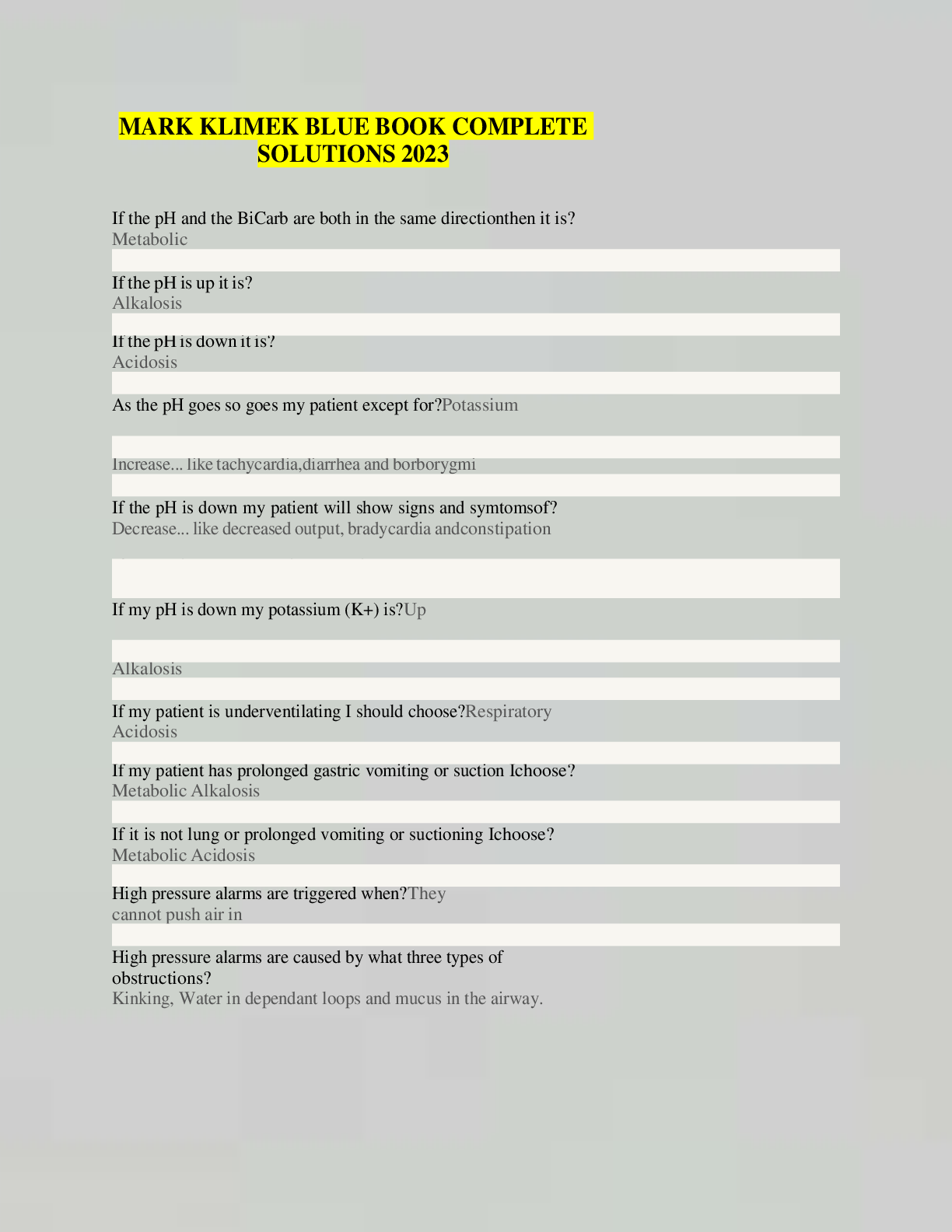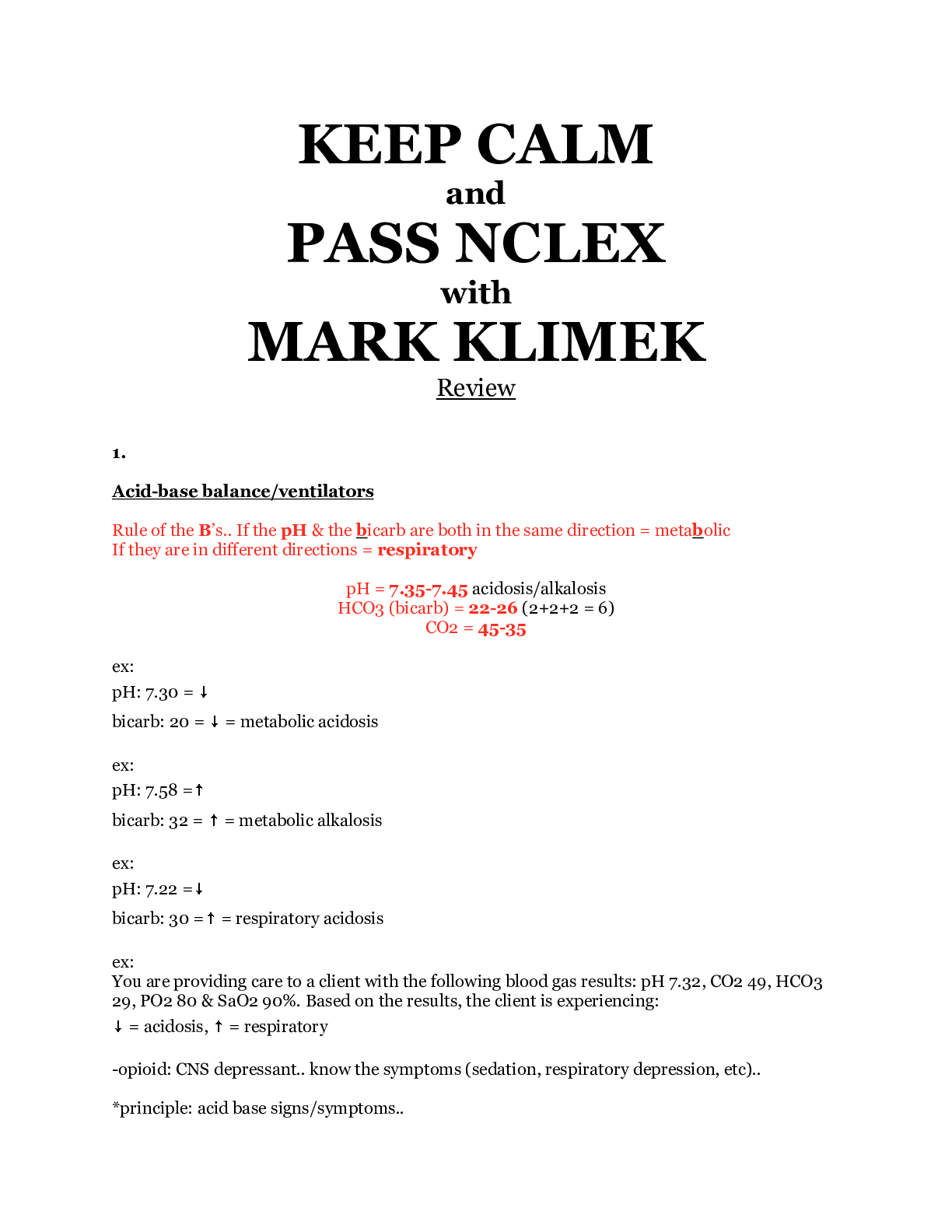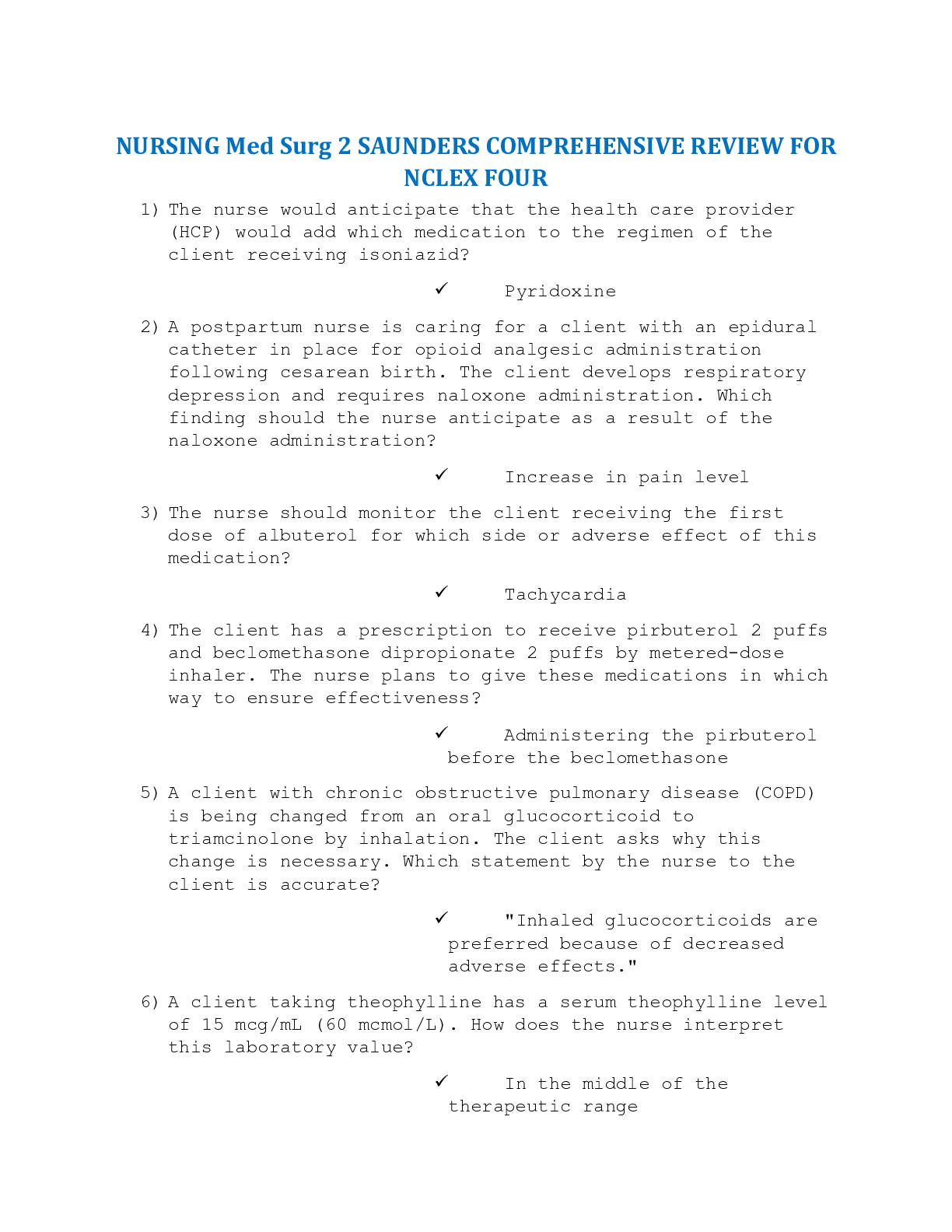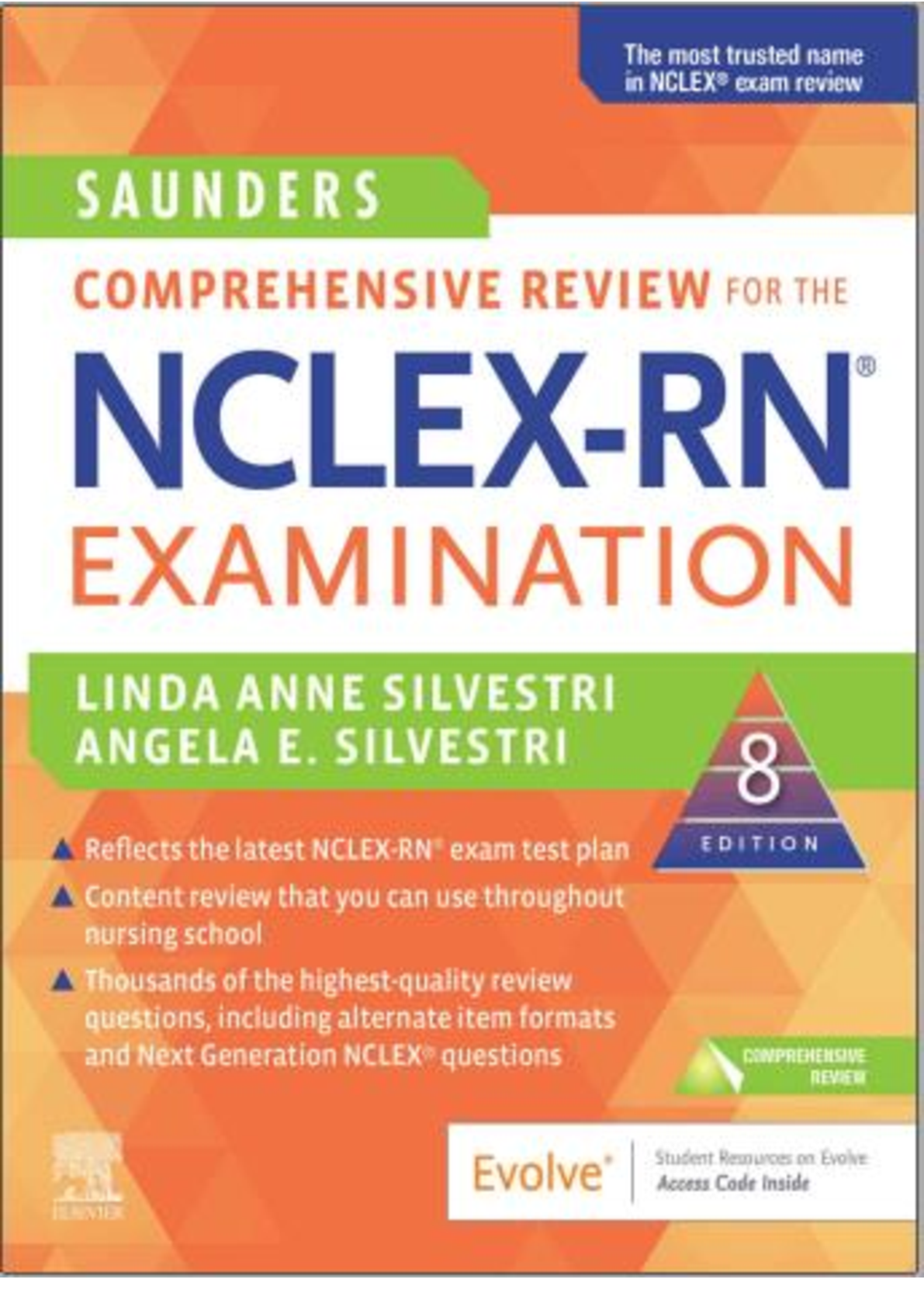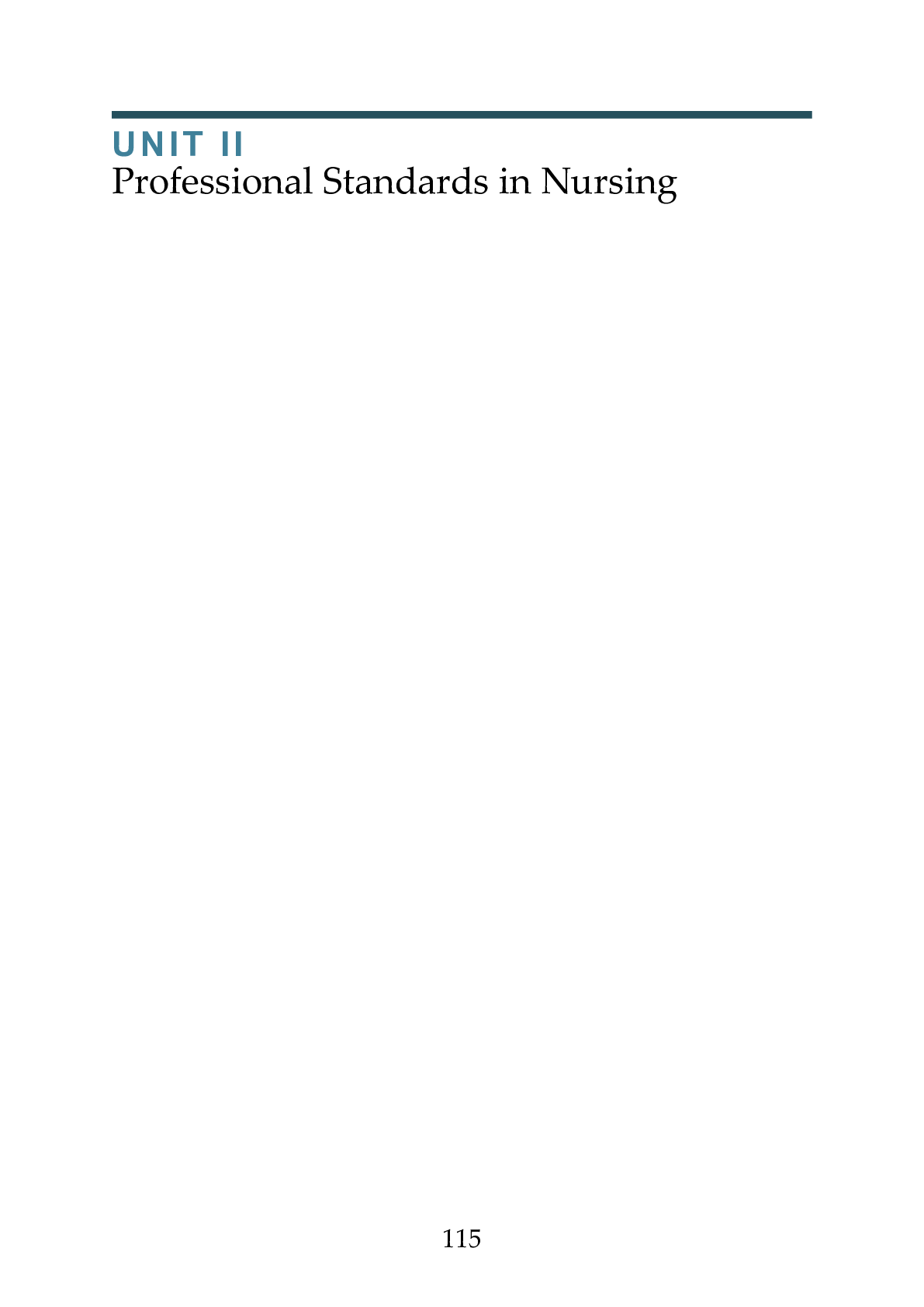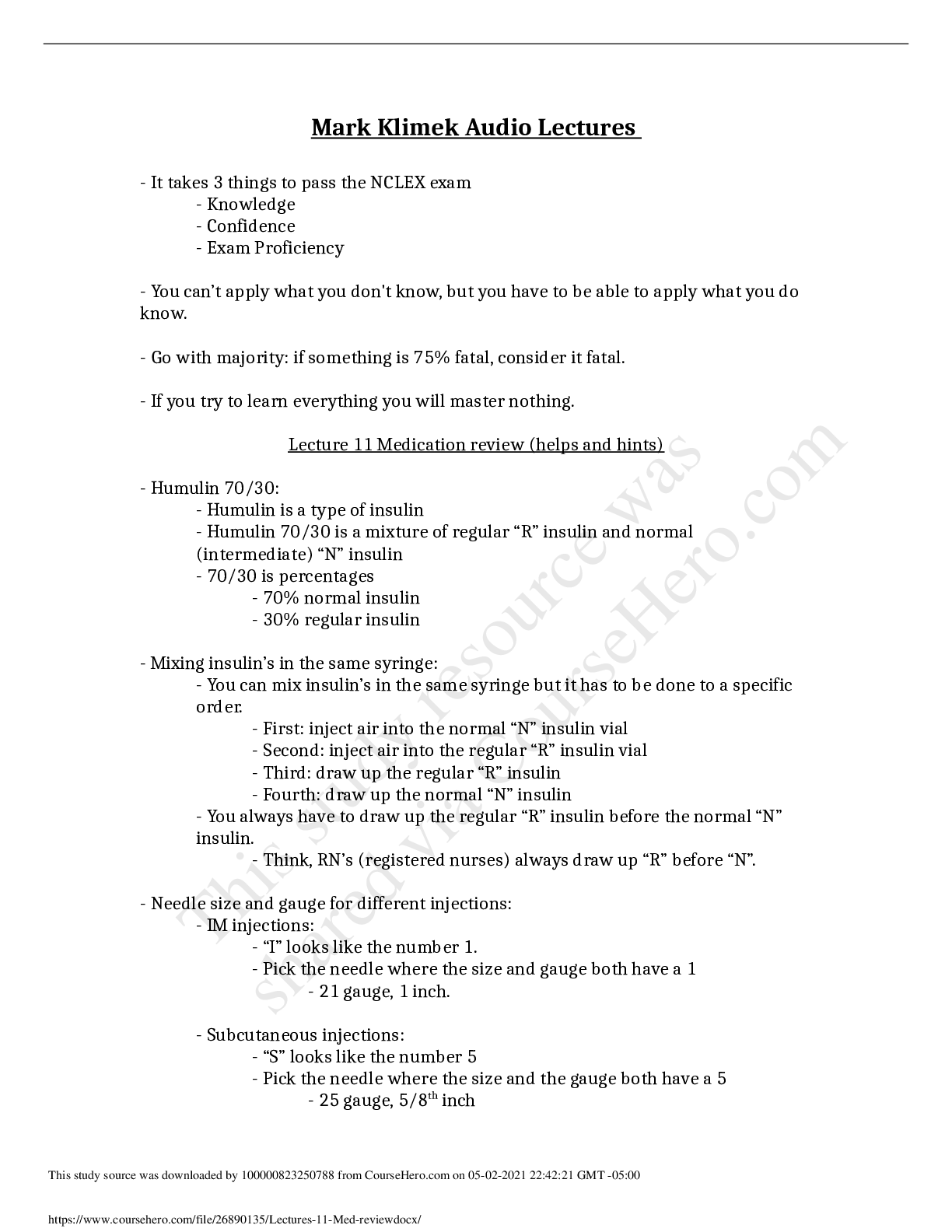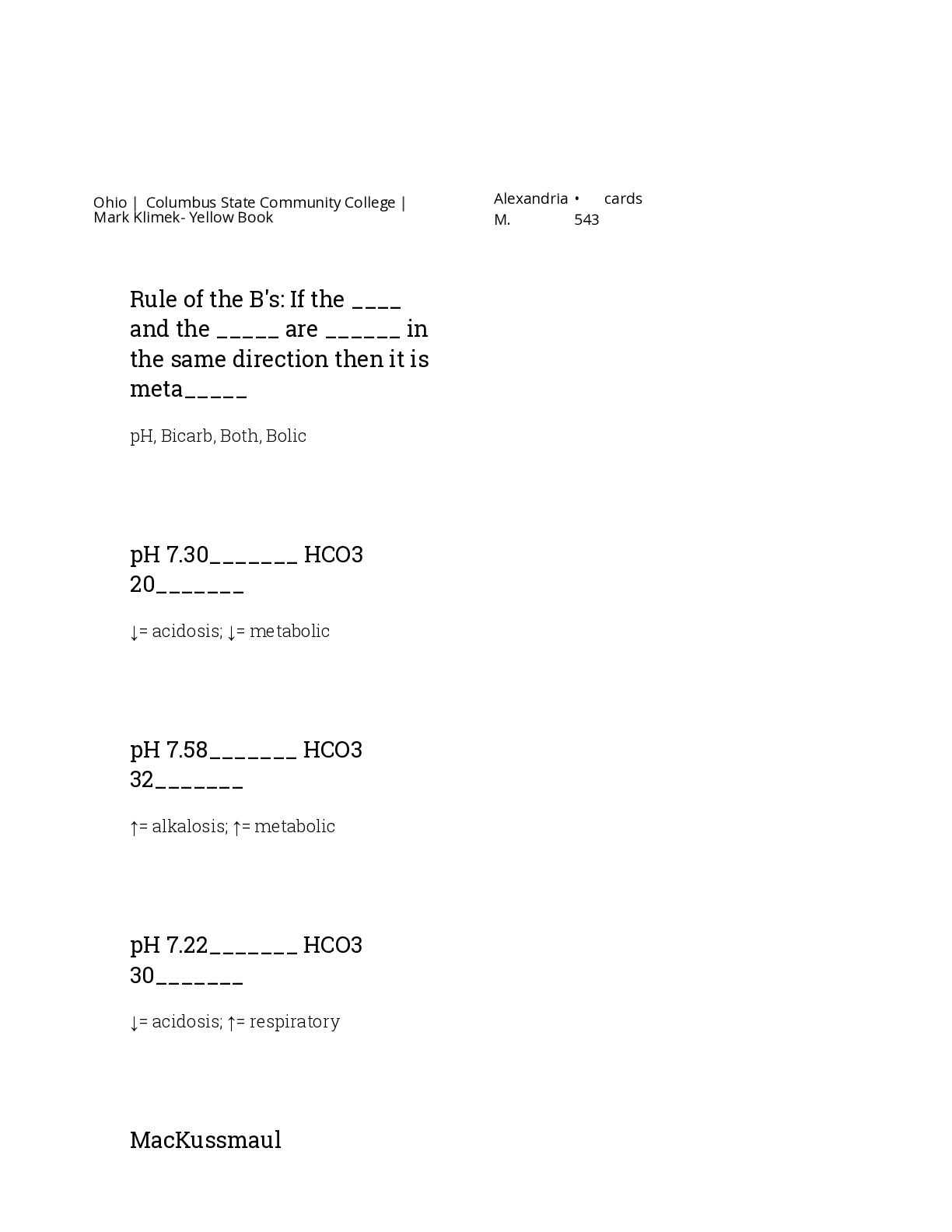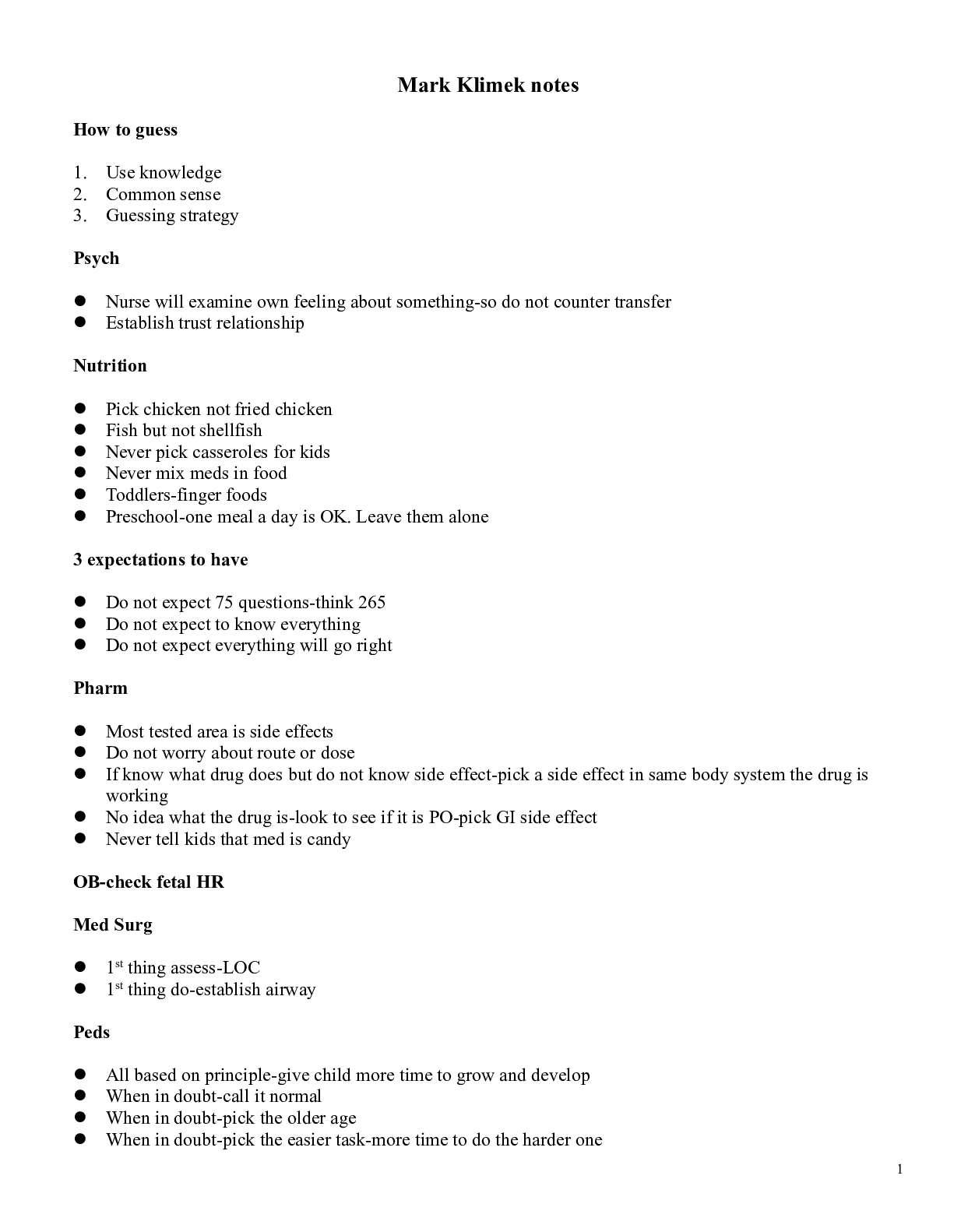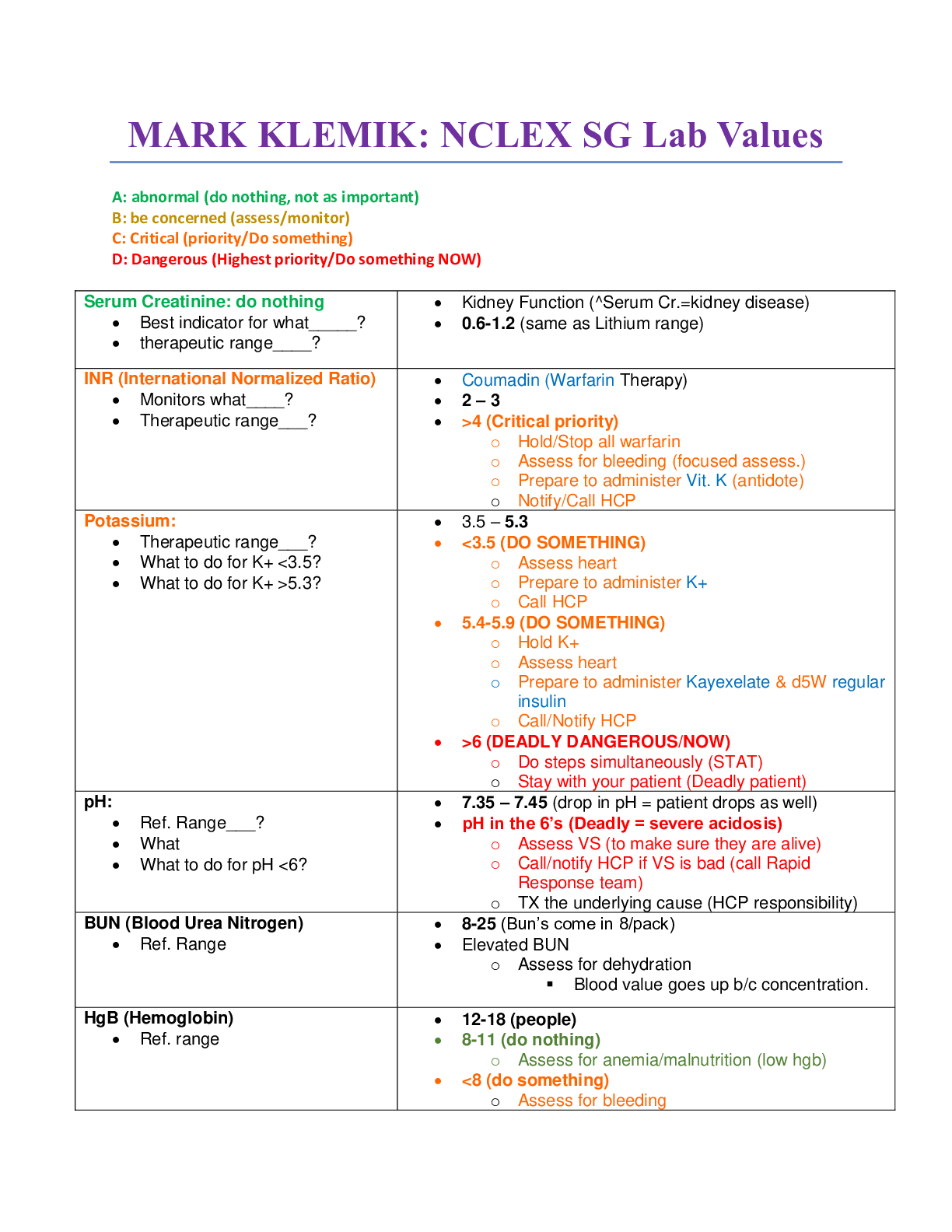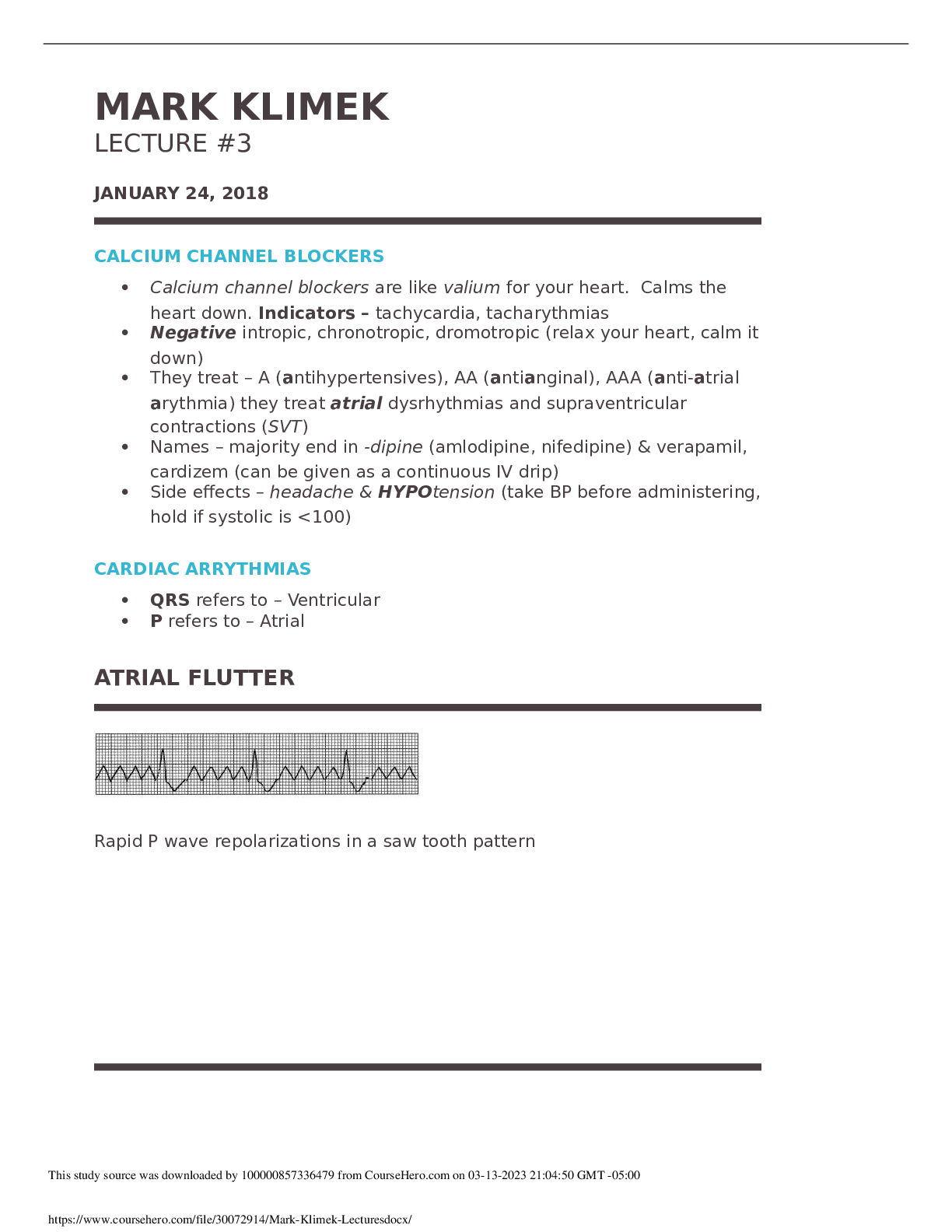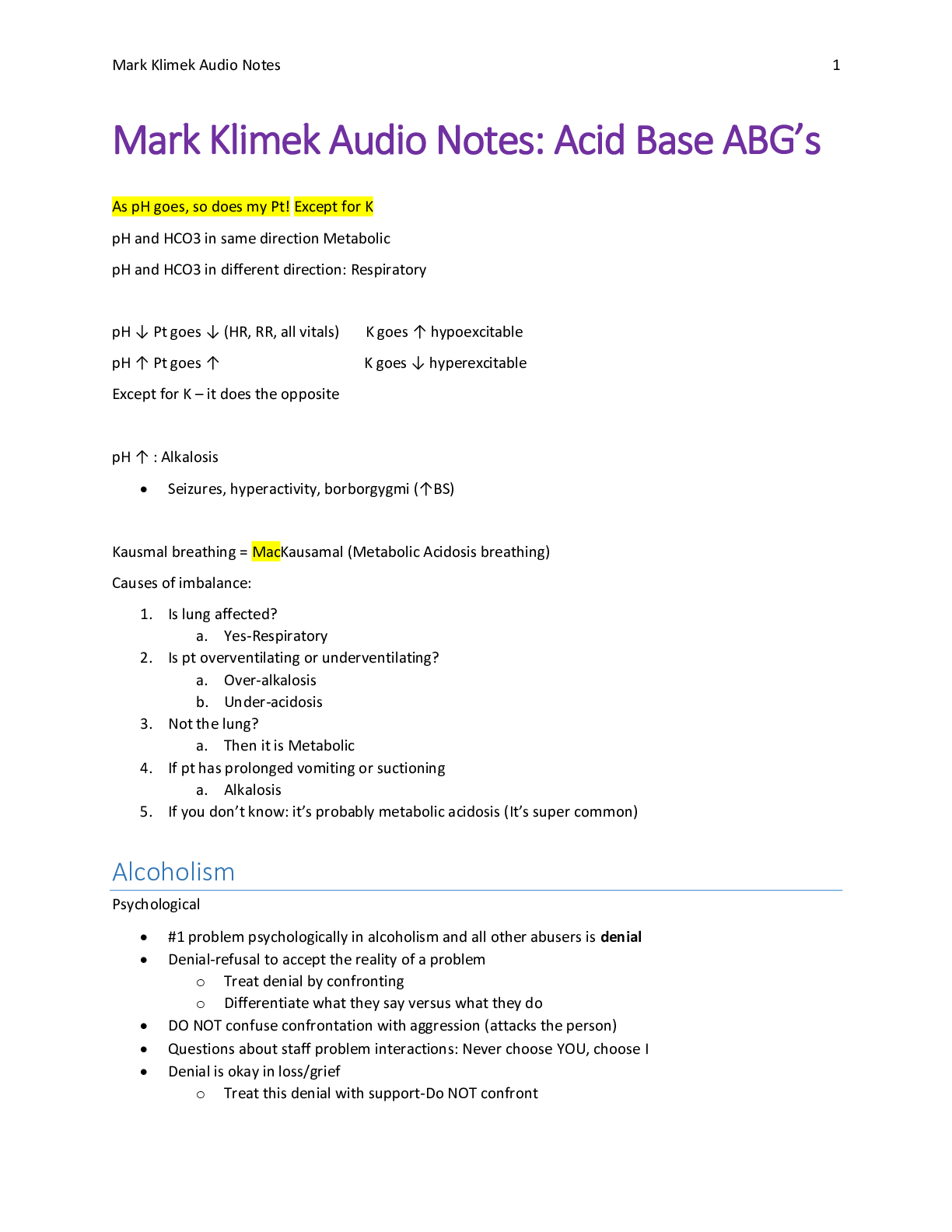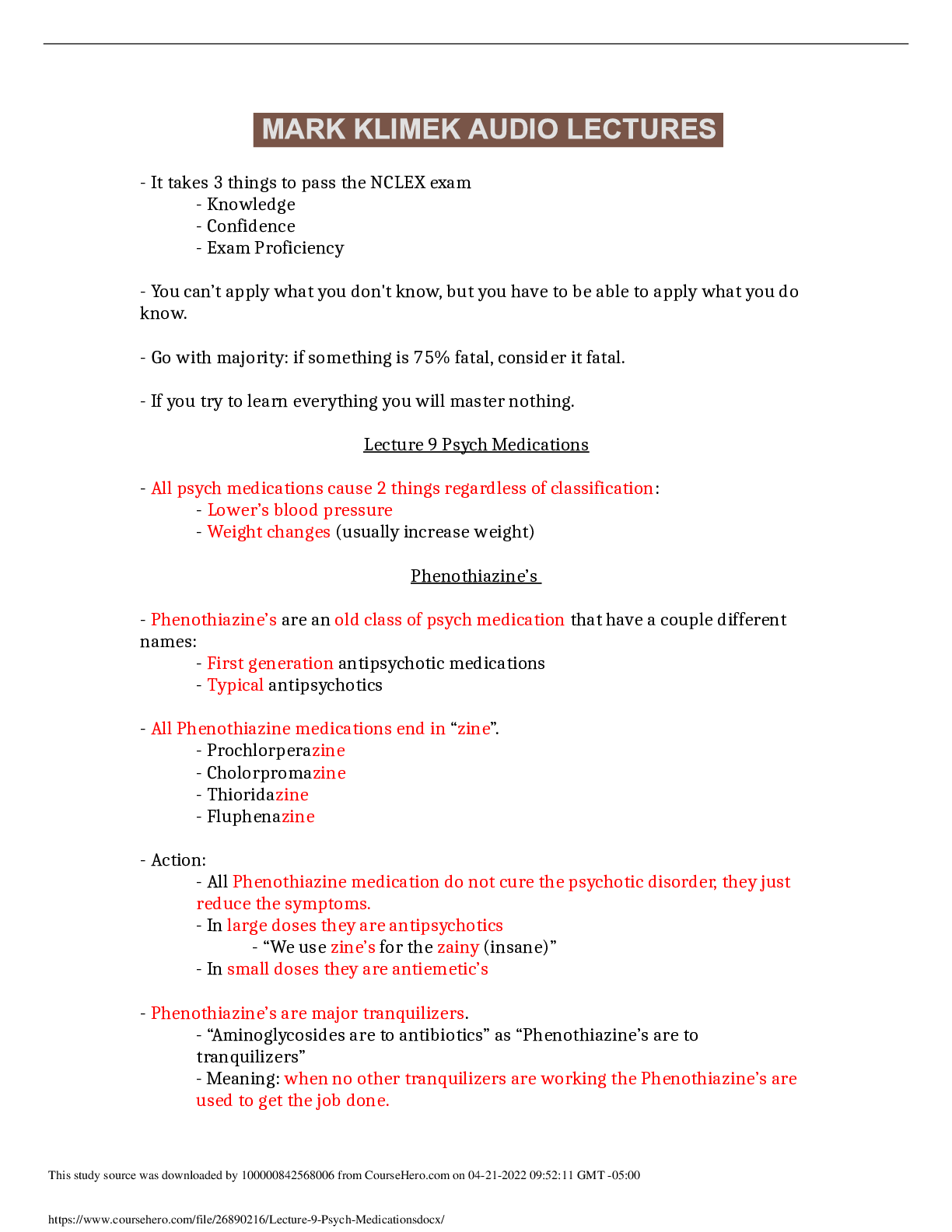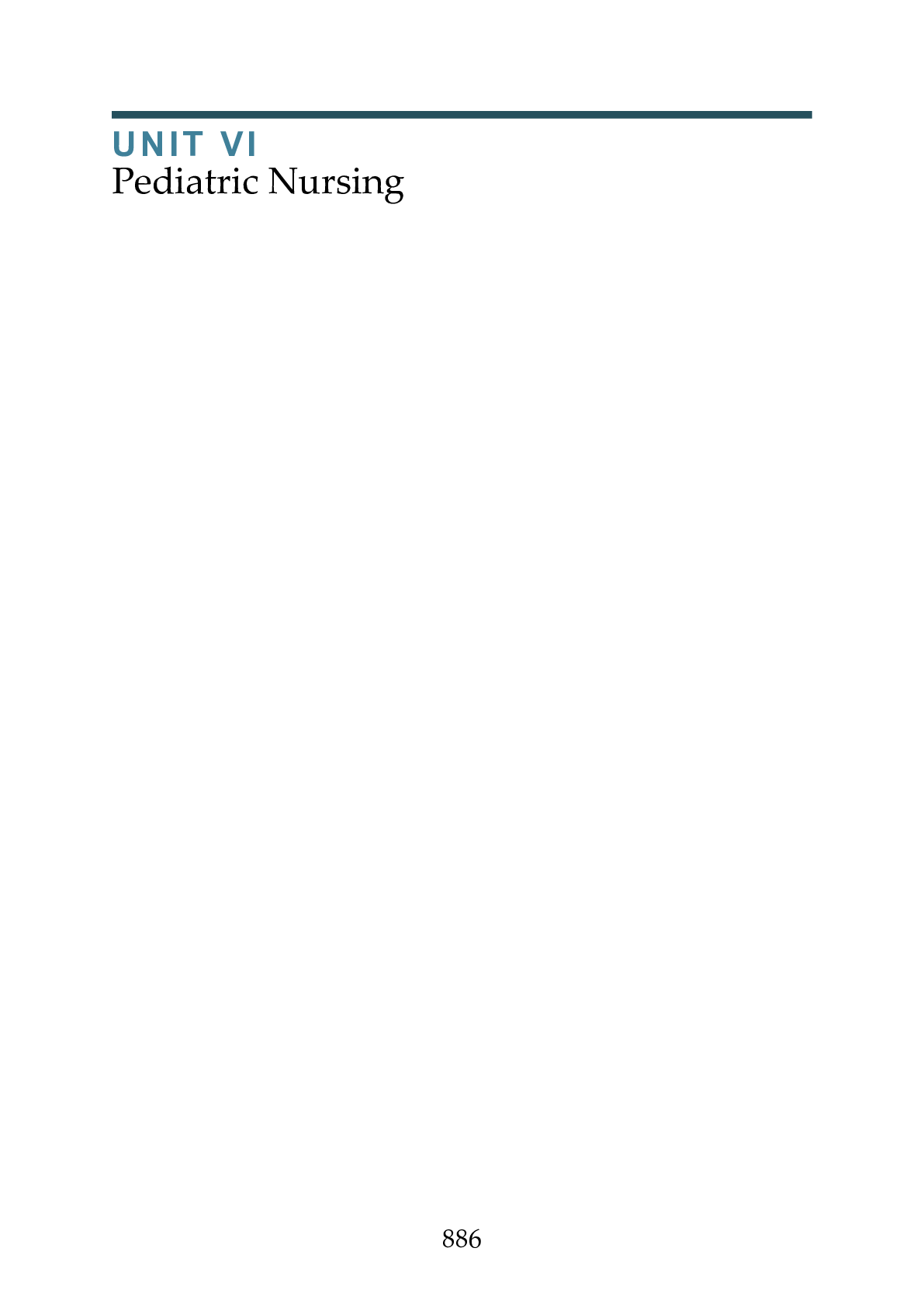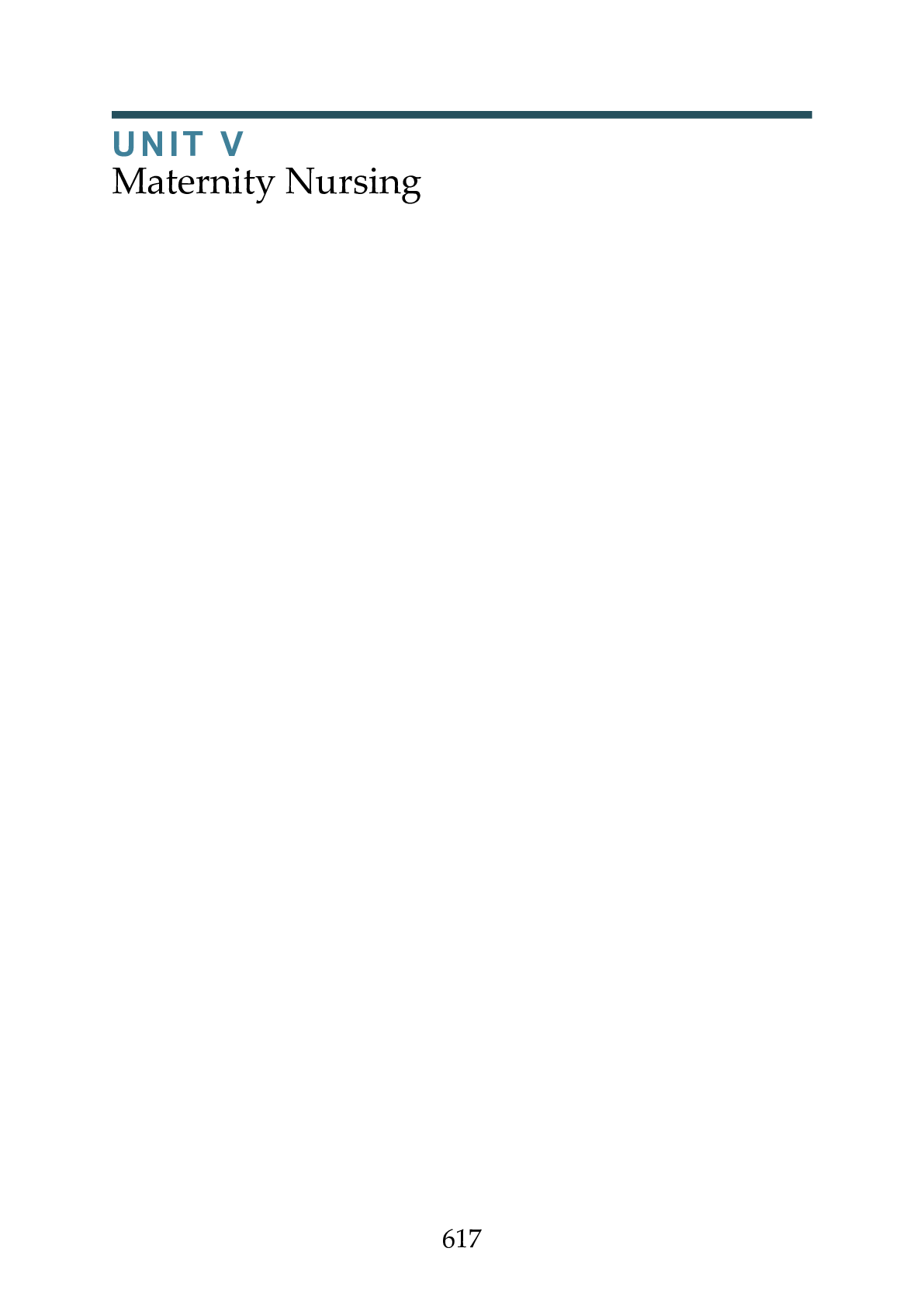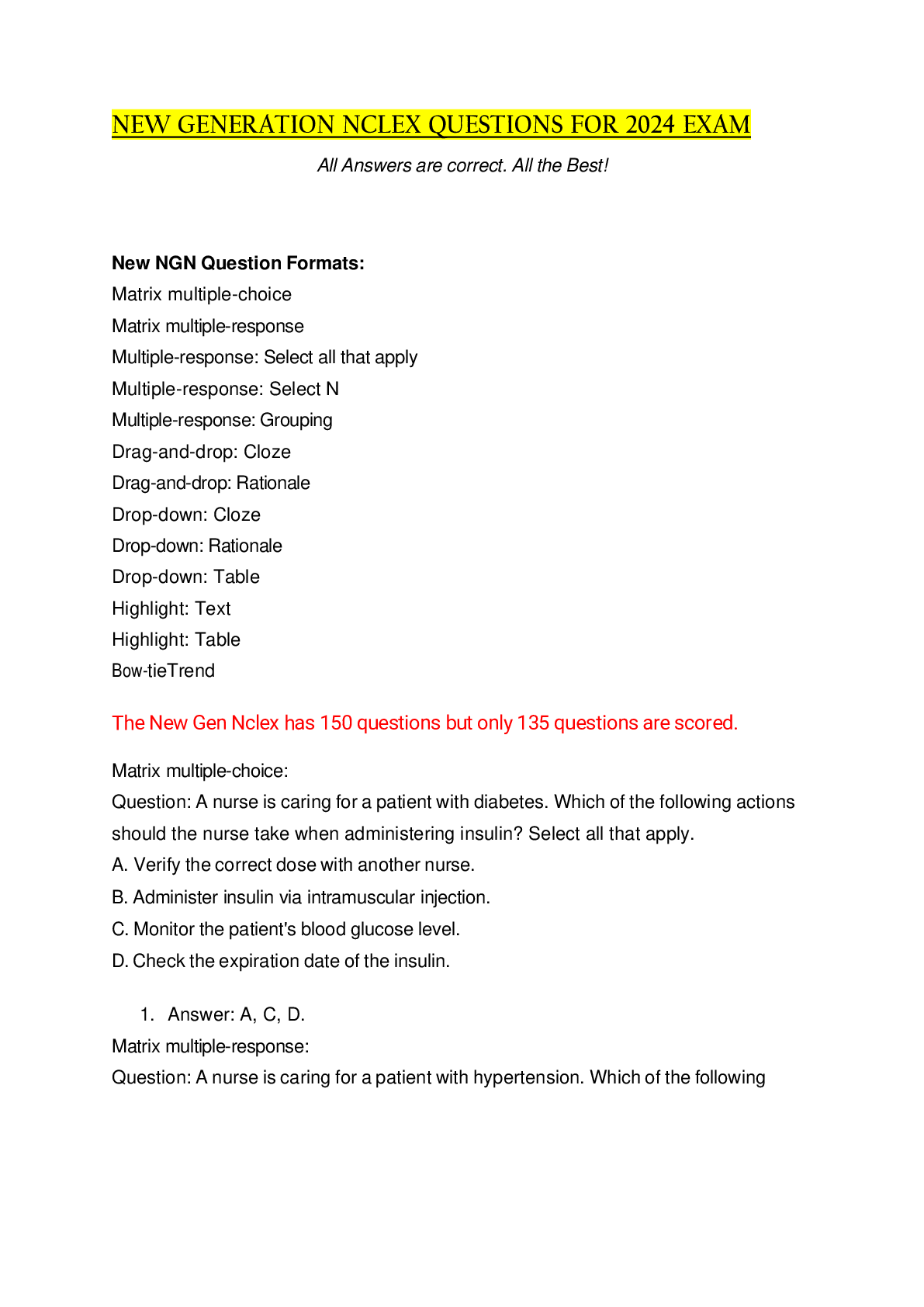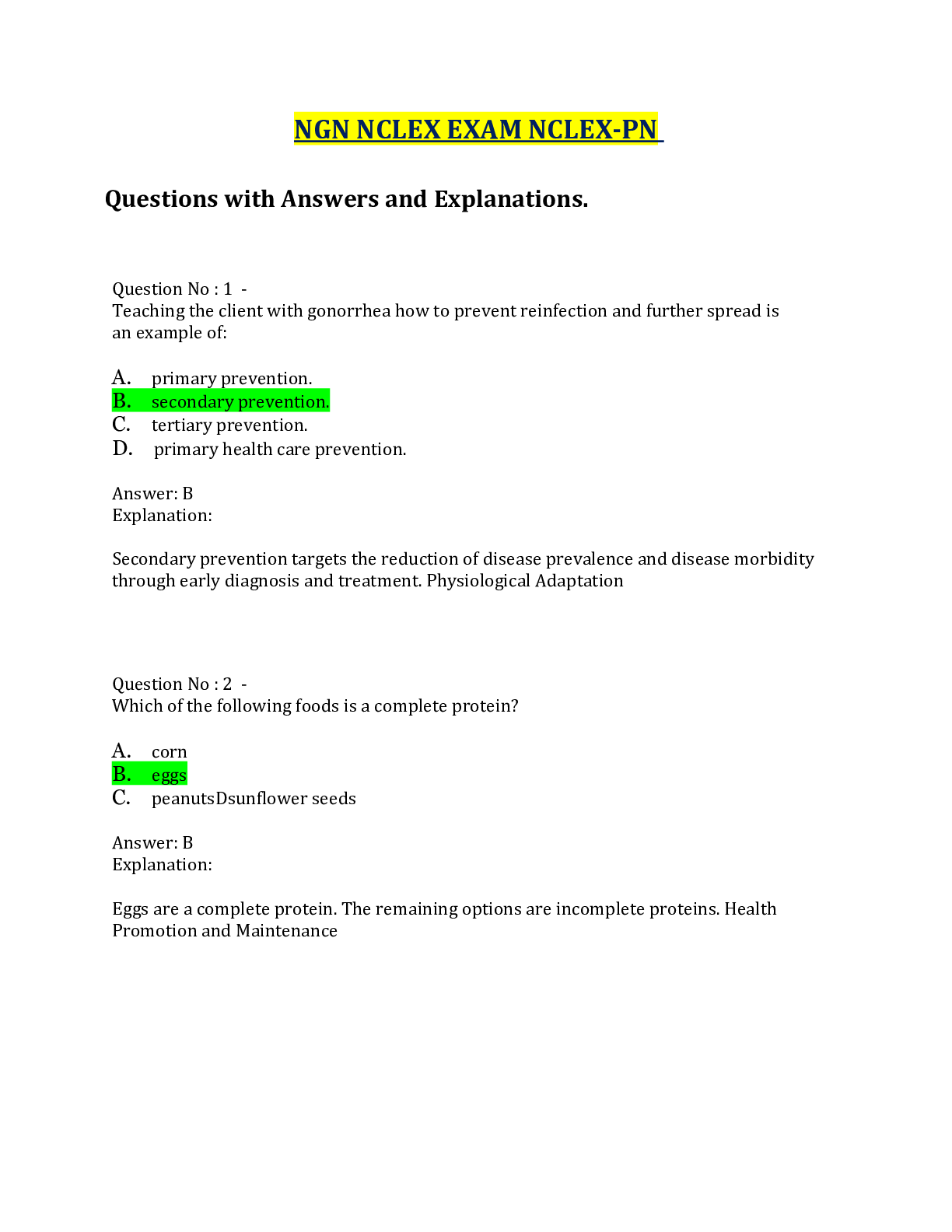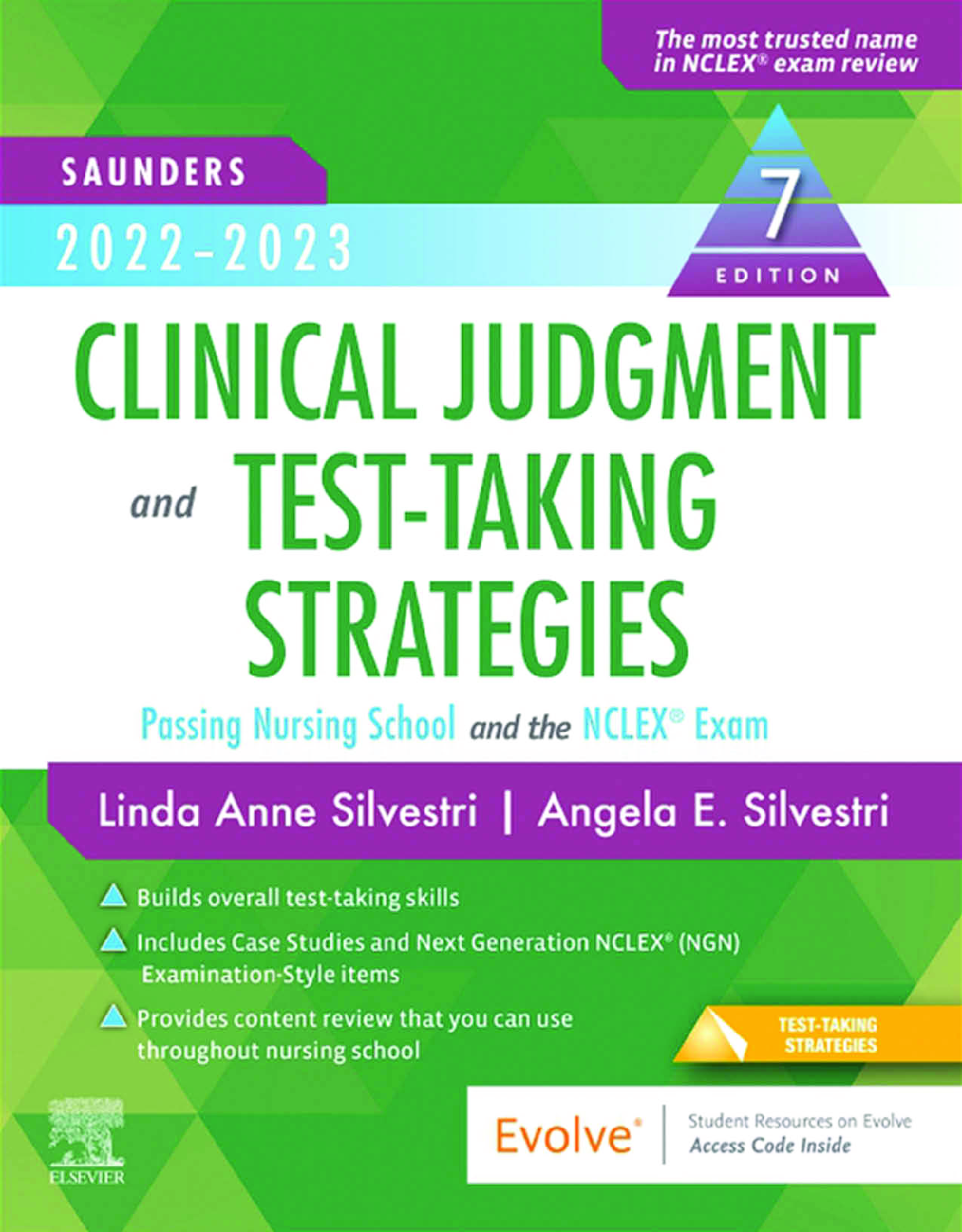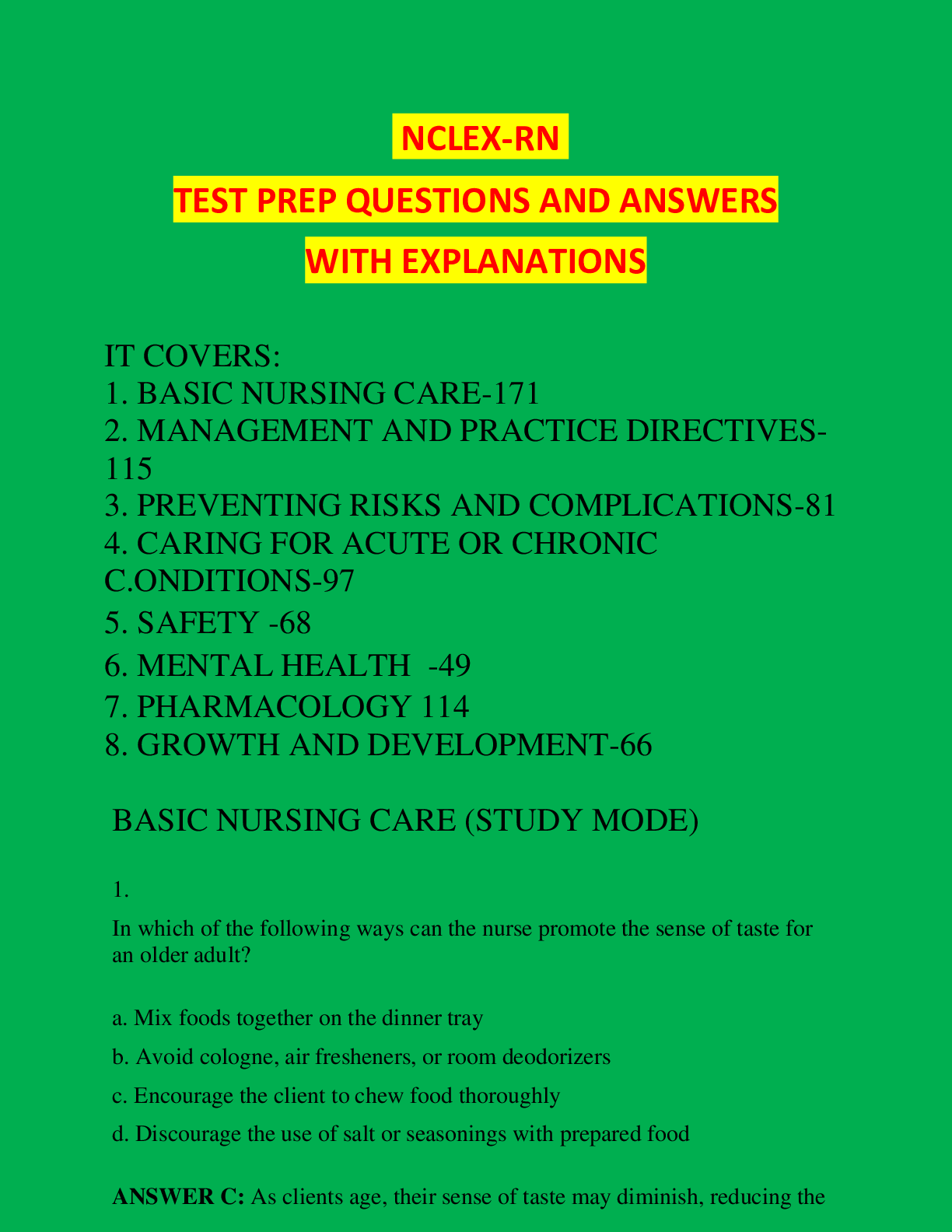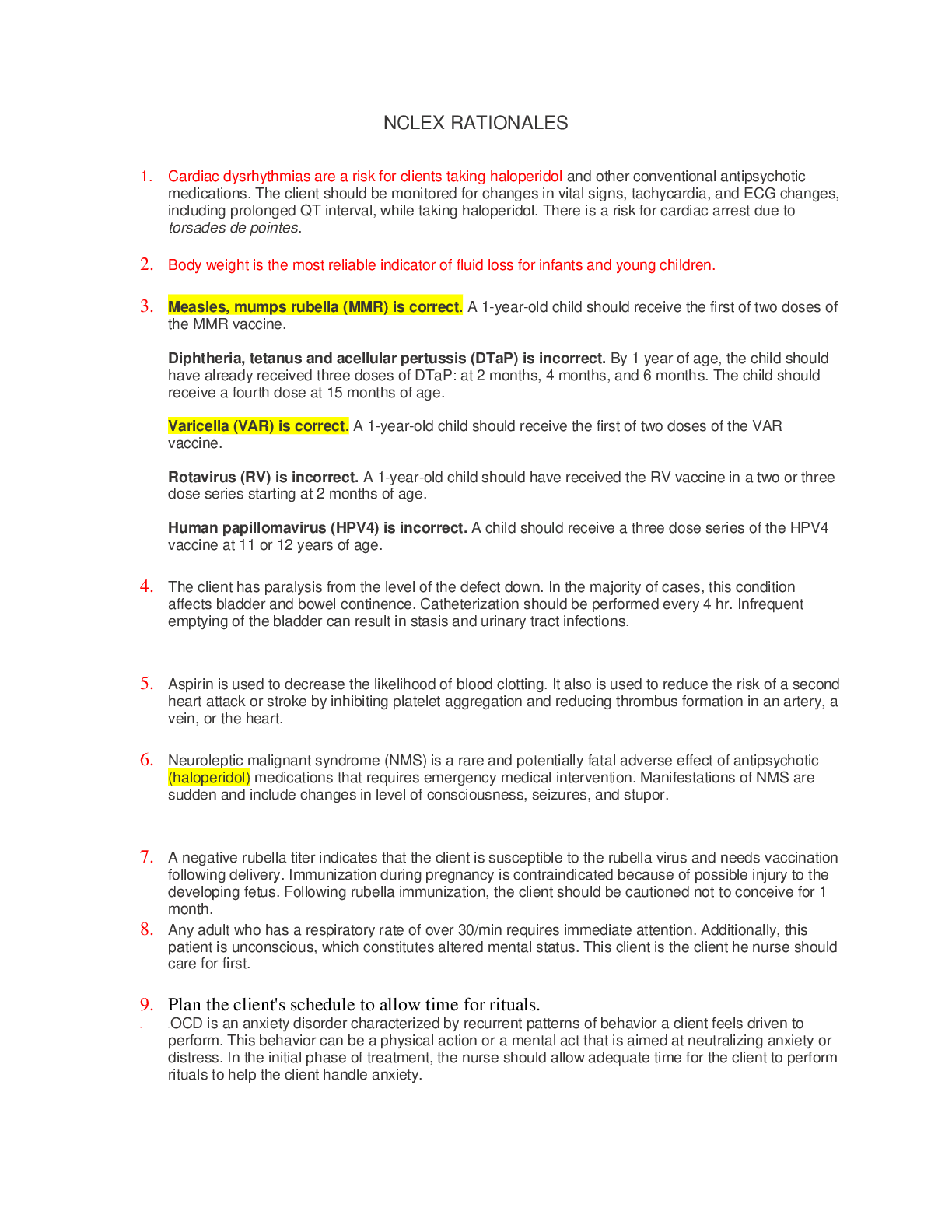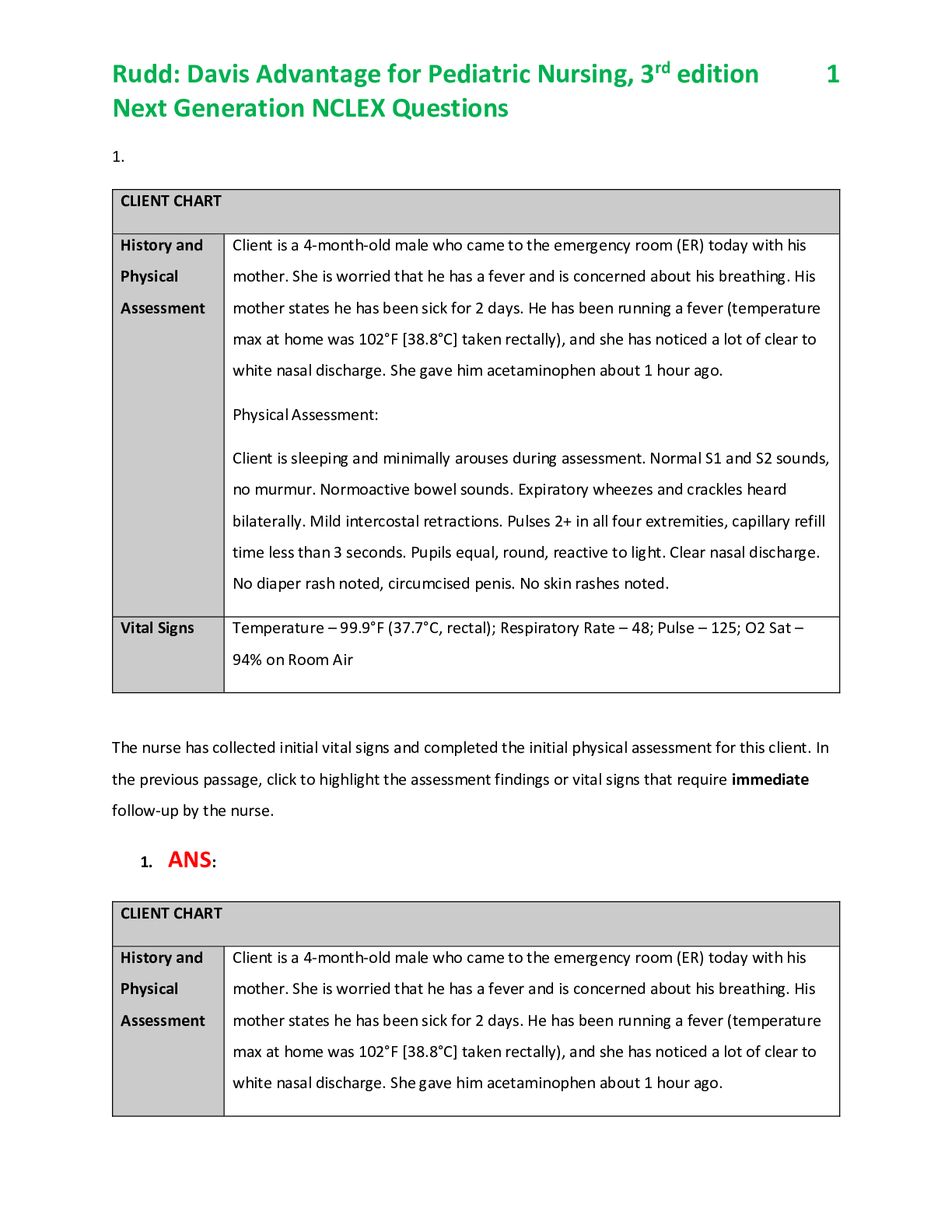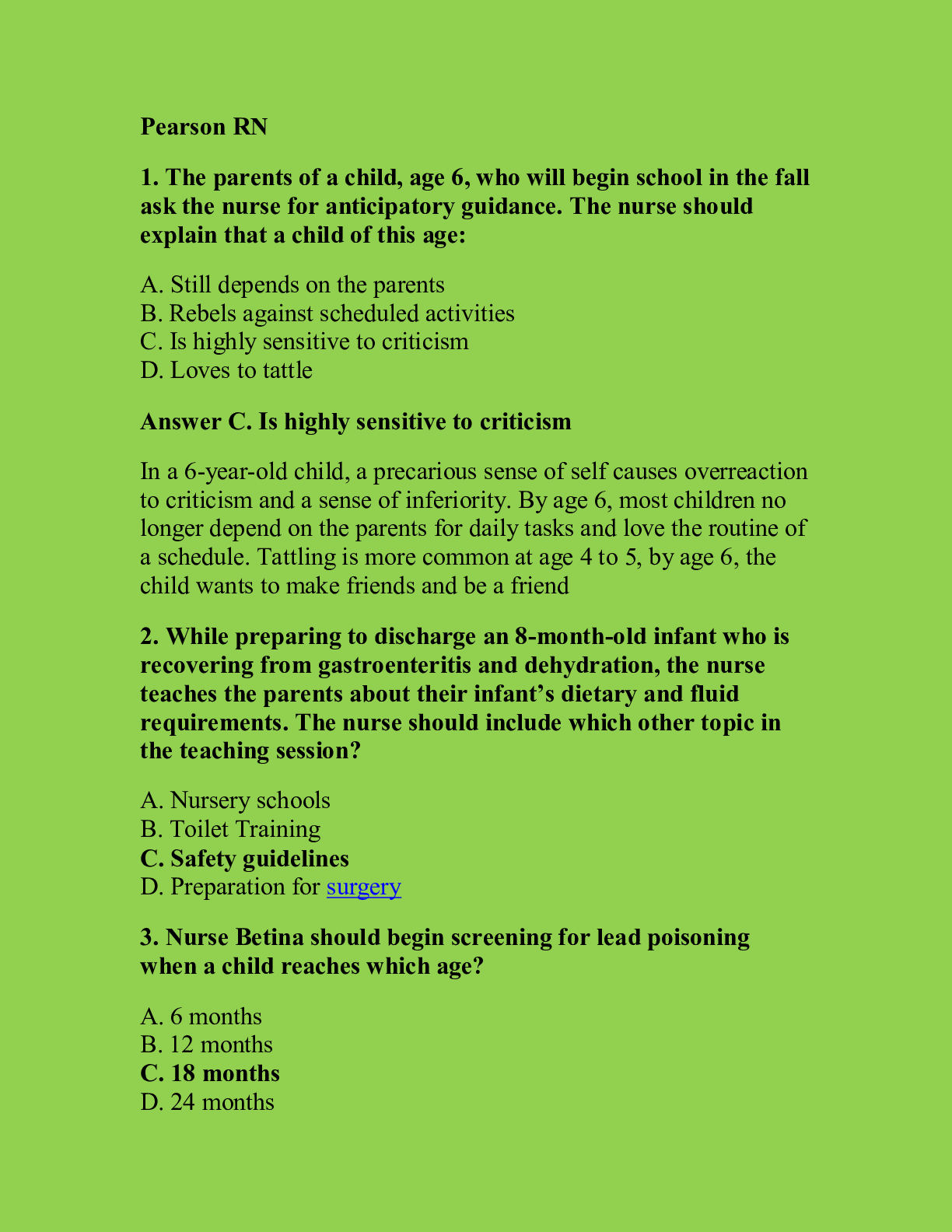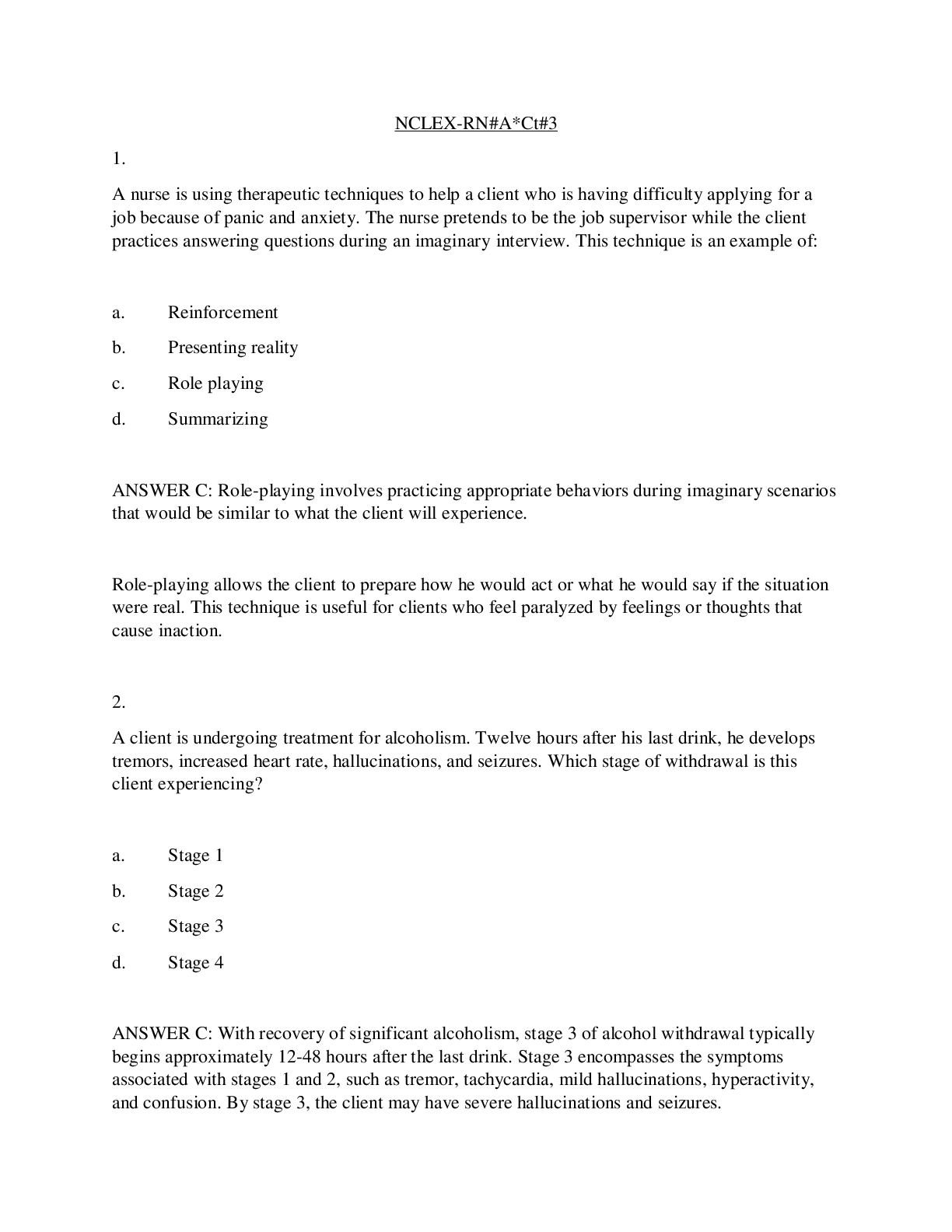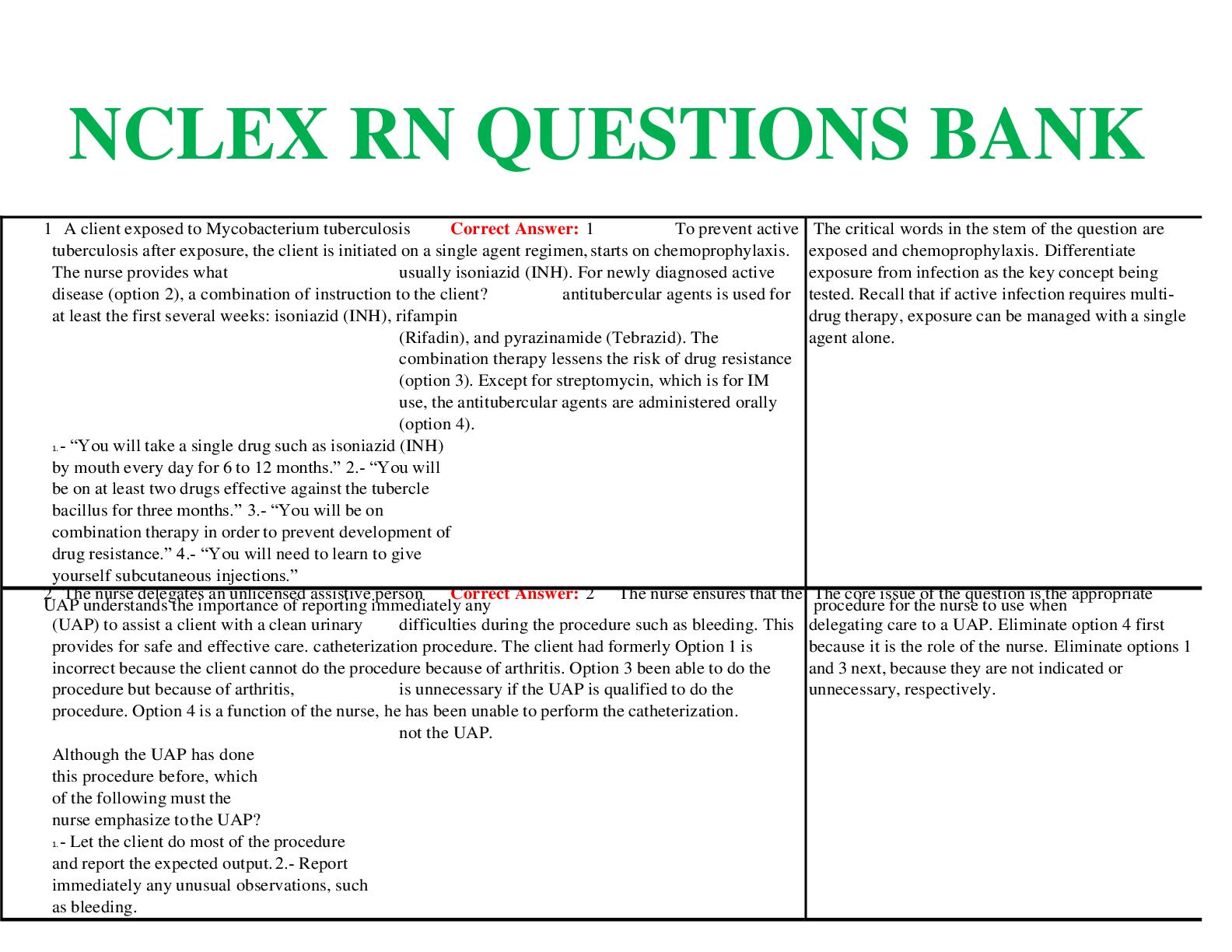*NURSING > NCLEX > Saunders Comprehensive NCLEX-RN Exam Review_UNIT 4; Growth and Development Across the Life Span. 90 (All)
Saunders Comprehensive NCLEX-RN Exam Review_UNIT 4; Growth and Development Across the Life Span. 90 Page Ch 17-19, and includes Questions, Answers and Rationale..
Document Content and Description Below
THIS DOCUMENT CONTAINS: C H A P T E R 1 7: Theories of Growth and Development C H A P T E R 1 8 : Growth, Development, and Stages of Life C H A P T E R 1 9: Care of the Older Client PRACTICE ... QUESTIONS 149. The clinic nurse is preparing to explain the concepts of Kohlberg’s theory of moral development with a parent. The nurse should tell the parent that which factor motivates good and bad actions for the child at the preconventional level? 1. Peer pressure 2. Social pressure 3. Parents’ behavior 4. Punishment and reward 150. The maternity nurse is providing instructions to a new mother regarding the psychosocial development of the newborn infant. Using Erikson’s psychosocial development theory, the nurse instructs the mother to take which measure? 1. Allow the newborn infant to signal a need. 2. Anticipate all needs of the newborn infant. 3. Attend to the newborn infant immediately when crying. 4. Avoid the newborn infant during the first 10 minutes of crying. 540151. The nurse notes that a 6-year-old child does not recognize that objects exist when the objects are outside of the visual field. Based on this observation, which action should the nurse take? 1. Report the observation to the pediatrician 2. Move the objects in the child’s direct field of vision. 3. Teach the child how to visually scan the environment. 4. Provide additional lighting for the child during play activities. 152. A nursing student is presenting a clinical conference to peers regarding Freud’s psychosexual stages of development, specifically the anal stage. The student explains to the group that which characteristic relates to the anal stage? 1. This stage is associated with toilet training. 2. This stage is characterized by the gratification of self. 3. This stage is characterized by a tapering off of conscious biological and sexual urges. 4. This stage is associated with pleasurable and conflicting feelings about the genital organs. 153. The nurse is describing Piaget’s cognitive developmental theory to pediatric nursing staff. The nurse should tell that staff that which child behavior is characteristic of the formal operations stage? 1. The child has the ability to think abstractly. 2. The child begins to understand the environment. 3. The child is able to classify, order, and sort facts. 4. The child learns to think in terms of past, present, and future. 154. The mother of an 8-year-old child tells the clinic nurse that she is concerned about the child because the child seems to be more attentive to friends than anything else. Using Erikson’s psychosocial development theory, the nurse should make which response? 1. “You need to be concerned.” 2. “You need to monitor the child’s behavior closely.” 3. “At this age, the child is developing his own personality.” 4. “You need to provide more praise to the child to stop this behavior.” 155. The nurse educator is preparing to conduct a teaching session for the nursing staff regarding the theories of growth and development and plans to discuss Kohlberg’s theory of moral development. What information should the nurse include in the session? Select all that apply. 1. Individuals move through all 6 stages in a sequential fashion. 2. Moral development progresses in relationship to cognitive development. 3. A person’s ability to make moral judgments develops over a period of time. 4. The theory provides a framework for understanding how individuals determine a moral code to guide their behavior. 5. In stage 1 (punishment-obedience orientation), children are 541expected to reason as mature members of society. 6. In stage 2 (instrumental-relativist orientation), the child conforms to rules to obtain rewards or have favors returned. 156. A parent of a 3-year-old tells a clinic nurse that the child is rebelling constantly and having temper tantrums. Using Erikson’s psychosocial development theory, which instructions should the nurse provide to the parent? Select all that apply. 1. Set limits on the child’s behavior. 2. Ignore the child when this behavior occurs. 3. Allow the behavior, because this is normal at this age period. 4. Provide a simple explanation of why the behavior is unacceptable. 5. Punish the child every time the child says “no” to change the behavior 157. A 4-year-old child diagnosed with leukemia is hospitalized for chemotherapy. The child is fearful of the hospitalization. Which nursing intervention should be implemented to alleviate the child’s fears? 1. Encourage the child’s parents to stay with the child. 2. Encourage play with other children of the same age. 5873. Advise the family to visit only during the scheduled visiting hours. 4. Provide a private room, allowing the child to bring favorite toys from home. 158. A 16-year-old client is admitted to the hospital for acute appendicitis and an appendectomy is performed. Which nursing intervention is most appropriate to facilitate normal growth and development postoperatively? 1. Encourage the client to rest and read. 2. Encourage the parents to room in with the client. 3. Allow the family to bring in the client’s favorite computer games. 4. Allow the client to interact with others in his or her same age group. 159. Which car safety device should be used for a child who is 8 years old and 4 feet tall? 1. Seat belt 2. Booster seat 3. Rear-facing convertible seat 4. Front-facing convertible seat 160. The nurse assesses the vital signs of a 12-month-old infant with a respiratory infection and notes that the respiratory rate is 35 breaths per minute. On the basis of this finding, which action is most appropriate? 1. Administer oxygen. 2. Document the findings. 3. Notify the pediatrician. 4. Reassess the respiratory rate in 15 minutes. 161. The nurse is monitoring a 3-month-old infant for signs of increased intracranial pressure. On palpation of the fontanels, the nurse notes that the anterior fontanel is soft and flat. On the basis of this finding, which nursing action is most appropriate? 1. Increase oral fluids. 2. Document the finding. 3. Notify the pediatrician. 4. Elevate the head of the bed to 90 degrees. 162. The nurse is evaluating the developmental level of a 2-year-old. Which does the nurse expect to observe in this child? 1. Uses a fork to eat 2. Uses a cup to drink 3. Pours own milk into a cup 4. Uses a knife for cutting food 163. A 2-year-old child is treated in the emergency department for a burn to the chest and abdomen. The child sustained the burn by grabbing a cup of hot coffee that was left on the kitchen counter. The nurse reviews safety principles with the parents before discharge. Which statement by the parents indicates an understanding of measures to provide safety in the home? 1. “We will be sure not to leave hot liquids unattended.” 2. “I guess our children need to understand what the word hot means.” 3. “We will be sure that the children stay in their rooms when we 588work in the kitchen.” 4. “We will install a safety gate as soon as we get home so the children cannot get into the kitchen.” 164. A mother arrives at a clinic with her toddler and tells the nurse that she has a difficult time getting the child to go to bed at night. What measure is most appropriate for the nurse to suggest to the mother? 1. Allow the child to set bedtime limits. 2. Allow the child to have temper tantrums. 3. Avoid letting the child nap during the day. 4. Inform the child of bedtime a few minutes before it is time for bed. 165. The mother of a 3-year-old is concerned because her child still is insisting on a bottle at nap time and at bedtime. Which is the most appropriate suggestion to the mother? 1. Allow the bottle if it contains juice. 2. Allow the bottle if it contains water. 3. Do not allow the child to have the bottle. 4. Allow the bottle during naps but not at bedtime. 166. The nurse is preparing to care for a 5-year-old who has been placed in traction following a fracture of the femur. The nurse plans care, knowing that which is the most appropriate activity for this child? 1. A radio 2. A sports video 3. Large picture books 4. Crayons and a coloring book 167. The mother of a 3-year-old asks a clinic nurse about appropriate and safe toys for the child. The nurse should tell the mother that the most appropriate toy for a 3-year-old is which? 1. A wagon 2. A golf set 3. A farm set 4. A jack set with marbles 168. Which interventions are appropriate for the care of an infant? Select all that apply. 1. Provide swaddling. 2. Talk in a loud voice. 3. Provide the infant with a bottle of juice at nap time. 4. Hang mobiles with black and white contrast designs. 5. Caress the infant while bathing or during diaper changes. 6. Allow the infant to cry for at least 10 minutes before responding. 169. The nurse is preparing to care for a dying client, and several family members are at the client’s bedside. Which therapeutic techniques should the nurse use when communicating with the family? Select all that apply. 5891. Discourage reminiscing. 2. Make the decisions for the family. 3. Encourage expression of feelings, concerns, and fears. 4. Explain everything that is happening to all family members. 5. Touch and hold the client’s or family member’s hand if appropriate. 6. Be honest and let the client and family know they will not be abandoned by the nurse. 170. An infant receives a diphtheria, tetanus, and acellular pertussis (DTaP) immunization at a well-baby clinic. The parent returns home and calls the clinic to report that the infant has developed swelling and redness at the site of injection. Which intervention should the nurse suggest to the parent? 1. Monitor the infant for a fever. 2. Bring the infant back to the clinic. 3. Apply a hot pack to the injection site. 4. Apply a cold pack to the injection site. 171. A child is receiving a series of the hepatitis B vaccine and arrives at the clinic with his parent for the second dose. Before administering the vaccine, the nurse should ask the child and parent about a history of a severe allergy to which substance? 1. Eggs 2. Penicillin 3. Sulfonamides 4. A previous dose of hepatitis B vaccine or component 172. A parent brings her 4-month-old infant to a well-baby clinic for immunizations. The child is up to date with the immunization schedule. The nurse should prepare to administer which immunizations to this infant? 1. Varicella, hepatitis B vaccine (HepB) 2. Diphtheria, tetanus, acellular pertussis (DTaP); measles, mumps, rubella (MMR); inactivated poliovirus vaccine (IPV) 3. MMR, Haemophilus influenzae type b (Hib), DTaP 4. DTaP, Hib, IPV, pneumococcal vaccine (PCV), rotavirus vaccine (RV) 173. The clinic nurse is assessing a child who is scheduled to receive a live virus vaccine (immunization). What are the general contraindications associated with receiving a live virus vaccine? Select all that apply. 1. The child has symptoms of a cold. 2. The child had a previous anaphylactic reaction to the vaccine. 3. The mother reports that the child is having intermittent episodes of diarrhea. 4. The mother reports that the child has not had an appetite and has been fussy. 5905. The child has a disorder that caused a severely deficient immune system. 6. The mother reports that the child has recently been exposed to an infectious disease 174. The nurse is providing medication instructions to an older client who is taking digoxin daily. The nurse explains to the client that decreased lean body mass and decreased glomerular filtration rate, which are age-related body changes, could place the client at risk for which complication with medication therapy? 1. Decreased absorption of digoxin 2. Increased risk for digoxin toxicity 3. Decreased therapeutic effect of digoxin 4. Increased risk for side effects related to digoxin 175. The nurse is caring for an older client in a long-term care facility. Which action contributes to encouraging autonomy in the client? 1. Planning meals 2. Decorating the room 3. Scheduling haircut appointments 4. Allowing the client to choose social activities 176. The home care nurse is visiting an older client whose spouse died 6 months ago. Which behaviors by the client indicates effective coping? Select all that apply. 1. Neglecting personal grooming 2. Looking at old snapshots of family 3. Participating in a senior citizens program 4. Visiting the spouse’s grave once a month 5. Decorating a wall with the spouse’s pictures and awards received 177. The nurse is providing instructions to the assistive personnel (AP) regarding care of an older client with hearing loss. What should the nurse tell the AP about older clients with hearing loss? 1. They are often distracted. 2. They have middle ear changes. 3. They respond to low-pitched tones. 4. They develop moist cerumen production. 178. The nurse is providing an educational session to new employees, and the topic is abuse of the older client. The nurse helps the employees identify which client as most typically a victim of abuse? 1. A man who has moderate hypertension 2. A man who has newly diagnosed cataracts 3. A woman who has advanced Parkinson’s disease 4. A woman who has early diagnosed Lyme disease 179. The nurse is performing an assessment on an older client who is having difficulty sleeping at night. Which statement by the client indicates the need for further teaching regarding measures to improve sleep? 1. “I swim 3 times a week.” 2. “I have stopped smoking cigars.” 6103. “I drink hot chocolate before bedtime.” 4. “I read for 40 minutes before bedtime.” 180. The visiting nurse observes that the older male client is confined by his daughter-in-law to his room. When the nurse suggests that he walk to the den and join the family, he says, “I’m in everyone’s way; my daughter-in-law needs me to stay here.” Which is the most important action for the nurse to take? 1. Say to the daughter-in-law, “Confining your father-in-law to his room is inhumane.” 2. Suggest to the client and daughter-in-law that they consider a nursing home for the client. 3. Say nothing, because it is best for the nurse to remain neutral and wait to be asked for help. 4. Suggest appropriate resources to the client and daughter-in-law, such as respite care and a senior citizens center. 181. The nurse is performing an assessment on an older adult client. Which assessment data would indicate a potential complication associated with the skin? 1. Crusting 2. Wrinkling 3. Deepening of expression lines 4. Thinning and loss of elasticity in the skin 182. The home health nurse is visiting a client for the first time. While assessing the client’s medication history, it is noted that there are 19 prescriptions and several over-the-counter medications that the client has been taking. Which intervention should the nurse take first? 1. Check for medication interactions. 2. Determine whether there are medication duplications. 3. Determine whether a family member supervises medication administration. 4. Call the prescribing primary health care provider (PHCP) and report polypharmacy. 183. The long-term care nurse is performing assessments on several of the residents. Which are normal age-related physiological changes the nurse should expect to note? Select all that apply. 1. Increased heart rate 2. Decline in visual acuity 3. Decreased respirato [Show More]
Last updated: 1 year ago
Preview 1 out of 90 pages
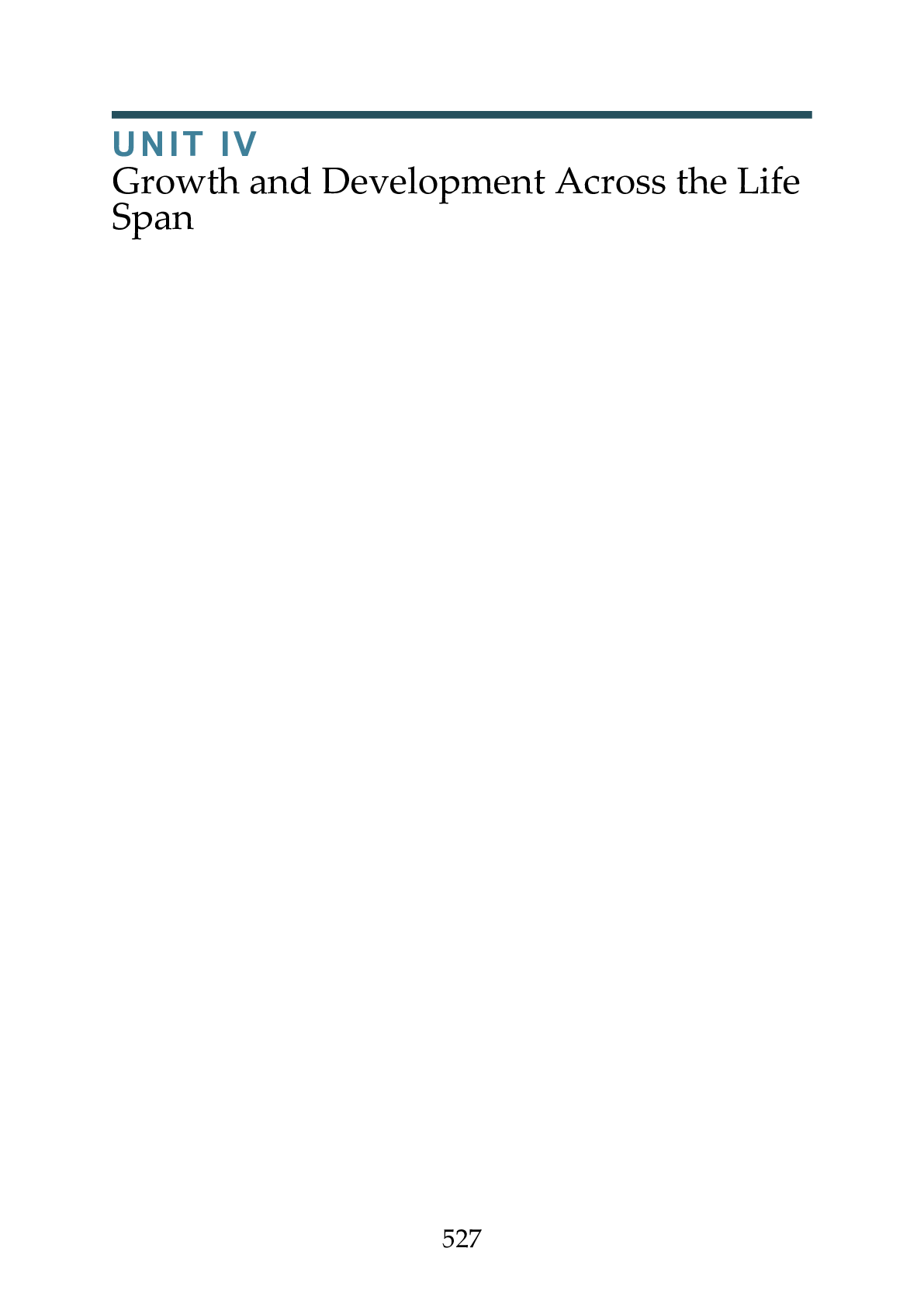
Reviews( 0 )
Document information
Connected school, study & course
About the document
Uploaded On
Apr 14, 2021
Number of pages
90
Written in
Additional information
This document has been written for:
Uploaded
Apr 14, 2021
Downloads
0
Views
159

